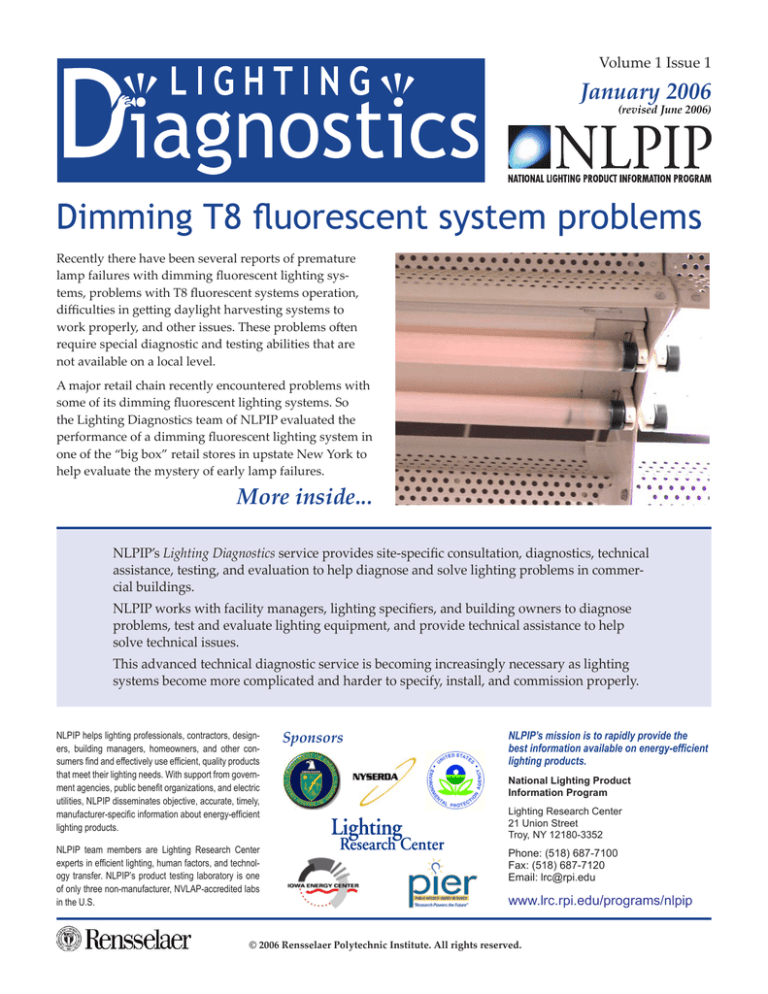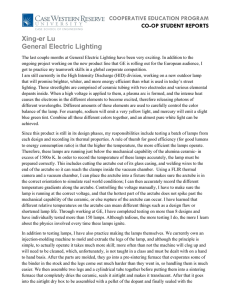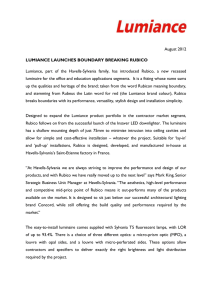
Volume 1 Issue 1
January 2006
(revised June 2006)
Dimming T8 fluorescent system problems
Recently there have been several reports of premature
lamp failures with dimming fluorescent lighting systems, problems with T8 fluorescent systems operation,
difficulties in getting daylight harvesting systems to
work properly, and other issues. These problems often
require special diagnostic and testing abilities that are
not available on a local level.
A major retail chain recently encountered problems with
some of its dimming fluorescent lighting systems. So
the Lighting Diagnostics team of NLPIP evaluated the
performance of a dimming fluorescent lighting system in
one of the “big box” retail stores in upstate New York to
help evaluate the mystery of early lamp failures.
More inside...
NLPIP’s Lighting Diagnostics service provides site-specific consultation, diagnostics, technical
assistance, testing, and evaluation to help diagnose and solve lighting problems in commercial buildings.
NLPIP works with facility managers, lighting specifiers, and building owners to diagnose
problems, test and evaluate lighting equipment, and provide technical assistance to help
solve technical issues.
This advanced technical diagnostic service is becoming increasingly necessary as lighting
systems become more complicated and harder to specify, install, and commission properly.
NLPIP helps lighting professionals, contractors, designers, building managers, homeowners, and other consumers find and effectively use efficient, quality products
that meet their lighting needs. With support from government agencies, public benefit organizations, and electric
utilities, NLPIP disseminates objective, accurate, timely,
manufacturer-specific information about energy-efficient
lighting products.
NLPIP team members are Lighting Research Center
experts in efficient lighting, human factors, and technology transfer. NLPIP’s product testing laboratory is one
of only three non-manufacturer, NVLAP-accredited labs
in the U.S.
Sponsors
NLPIP’s mission is to rapidly provide the
best information available on energy-efficient
lighting products.
National Lighting Product
Information Program
Lighting Research Center
21 Union Street
Troy, NY 12180-3352
Phone: (518) 687-7100
Fax: (518) 687-7120
Email: lrc@rpi.edu
www.lrc.rpi.edu/programs/nlpip
© 2006 Rensselaer Polytechnic Institute. All rights reserved.
In the field with Lighting Diagnostics...
Solving a lighting mystery
at a big box retail store
The Lighting Diagnostics team at NLPIP examined the
lighting system in a big box retail store in the Albany,
New York area to learn why fluorescent lamps used in a
dimming system were experiencing shortened life. The
system of 1350 luminaires (fixtures) and dimming ballasts had been installed as an energy-saving alternative.
The lamps have an average rated life of 30,000 hours.
The lighting system is rarely turned off and had been
operating for two years (approximately 17,500 hours).
Under ideal conditions, a lamp with a 30,000-hour average rated life would have an average life of 36,000 hours
when operated continously. Using the lamp manufacturer’s published mortality curve, one would expect less
than 3% failures at 17,500 hours of operation. The store
experienced more than 7% failures. Lighting Diagnostics
examined this dimming lighting system to determine the
causes of the higher than expected failure rate.
Setting
The store is two years old and features skylights and
dimming fluorescent lighting. The lighting system
includes 1350 luminaires with dimming ballasts and
four lamps in each (5400 lamps total). Fixed-output
luminaires were installed around the perimeter of the
store’s interior.
Lighting System
The store’s dimming system used dimming ballasts with
a range of 5%-100% light output, each operating four
lamps on two circuits (two lamps per circuit). T8 lamps
were rated at 30,000 hours life. The 8-foot luminaires had
two 4-foot sections and featured quick connect plugs at
each end for power and dimming wires. Lamp holders
featured slide-on mounting systems and medium bi-pin
connections. Top test ports in the lamp holders allowed
testing for electrode heating voltage and lamp voltage.
Map of lighting system (area tested shown in red)
Procedure
NLPIP investigators first determined how many failures
were in the store and where they were located. They
then created a map of the luminaires (shown at right)
and identified an area to investigate (marked in red) in
order to minimize the impact of the investigation on
customers and workers.
Lamp end darkening
Pink lamps
Symptoms
Symptoms found at the store
included shortened lamp life,
non-working lamps, lamps with
severe end-darkening, pink
lamps, and very low light output.
Findings
The investigation found several
types of problems relating to the
lamps, ballasts, luminaires, lamp
holders, and the installations
themselves.
Some of the problems identified by Lighting Diagnostics investigators are circled above.
Storewide:
Of the luminaires with at least one inoperative lamp:
• Problems appeared to be randomly distributed
throughout the store.
• 44% had lamps with open electrodes. Not all of these
lamps showed end darkening.
• 10% of the luminaires contained lamps that had
either failed or were inoperative.
• 41% had ballast failures. These ballasts were cold
to the touch, indicating they were not energized.
Voltage was verified at the input to all ballasts and
rechecked after turning the power off and on.
• 7% of the lamps had failed or were inoperative.
• 21% had luminaire anomalies such as wires not connected or wires connected improperly.
• 15% had installation anomalies such as lamps not
inserted properly or rotated into holders, lack of
continuity in electrode heating circuit, or luminaire
covers not installed properly.
Lessons Learned
Types of problems found
Examples
of wires not
connected in
luminaires
Dimming systems are more sensitive to installation issues
than full-output systems. Many of the problems would
not present the same impact on full-output systems.
• Lighting Diagnostics investigators found a number of
luminaires wired incorrectly.
• Expect open electrodes in all cases of incorrect wiring.
• The most likely cause of lamp failure is improper
luminaire wiring or lamp installation. Both prevent
electrode heating—crucial while dimming.
• Luminaire covers were in contact with lamps and
created phosphor burns on the lamps. Lamps are
sensitive to direct contact with grounded housings.
• Luminaire cover tabs were not installed correctly.
• Connectors were unplugged.
• Power wires were not connected.
Common lighting problems and causes
Lighting problems do not always cause complete failure. Symptoms may
include:
• Shortened lamp life
• Buzzing
• Darkened lamp ends
• Striation
• Pink lamps
• Unrealized energy savings
• Low light output
Many factors can contribute to lighting system problems. Lamps, luminaires
(fixtures), ballasts, and installation can all play a part. Any one problem may
not be noticeable. However, multiple problems together often become objectionable. A few examples of problem areas and their causes could include:
Lamps
• Broken electrodes
Installation
• Lamps not completely rotated
into holders correctly
• Lack of continuity in electrode
heating circuit
• Luminaire covers not installed
properly
Luminaires (Fixtures)
• Wires improperly connected
• Wires not connected
Ballasts
• Failed (will be cold to the
touch)
• Low input voltage
• No power to ballast
Troubleshooting Dimming Fluorescent Systems
Dimming fluorescent systems are more sensitive to potential installation problems compared to non-dimming
fluorescent systems. Many of the issues that have been identified are related to the removal of heating from
the lamp electrodes, which become necessary when dimming, especially to low levels. If the dimming fluorescent systems are used at full light output, many of these problems will probably go unnoticed until the lamps
are operated in the dimming condition for some time.
If you have lighting problems, begin by assessing the big picture. Examine the lamps, luminaires, and ballasts, including how those components were installed.
Check luminaires
Inspect the lamp holders for
damage. This could result in a
discontinuity to the electrode
heating circuit, thereby preventing proper electrode heating.
Tug on each ballast wire connected to the lamp holder to make
sure the wires are installed correctly. If a wire is not connected
securely, the lamp may operate,
but electrode heating will not be
applied.
Check to see if any part of the
luminaire housing is in direct
contact with any of the lamps.
Contact with the lamp may provide an alternative path for lamp
and/or electrode current.
Measure the electrode heating
voltage at each lamp holder, if
possible, to see if the voltage is
within the manufacturer’s limits.
A voltmeter or oscilloscope with
proper frequency response (> 300
kHz) is needed for this measurement, since the electrode heating
voltage can be at a high frequency (20-100kHz).
Check ballasts
Check if the ballast case is warm,
if all lamps are out. If the case is
cold, the ballast may not be getting any power, or there may be
another issue.
Check lamps
Check that lamps are properly
installed in the luminaire. Both
pins on each side of the lamps
should be in electrical contact
with the lamp holder. If the
lamps are not installed correctly,
proper electrode heating will not
be provided during dimming.



